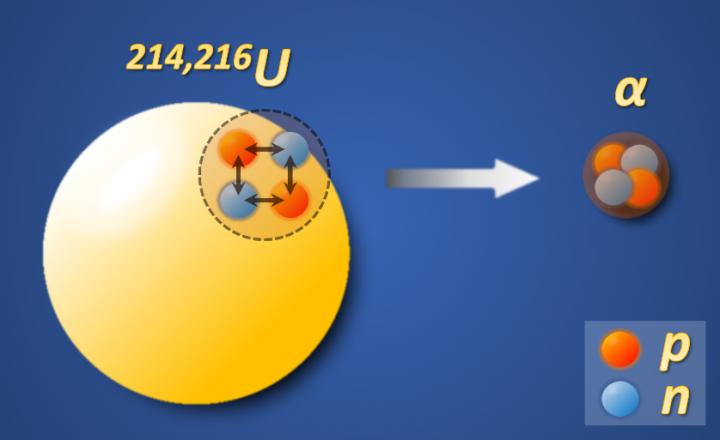
Credit: ZHANG Zhiyuan
It is always exciting to find new isotopes with extreme neutron/proton numbers in nuclear physics research. In the region of heavy nuclei, α-decay is one of the pervasive decay modes and plays an essential role in searching for new isotopes. However, even after about a century of studying α-decay, scientists still cannot perfectly describe how the α-particle is formed at the surface of the nucleus before its emission.
In the α-decay process, the α-particle can be regarded not only as two protons plus two neutrons, but also as two proton-neutron pairs. Although previous studies have proved the importance of the pairing forces between the identical nucleons, it remains unclear whether the strong proton-neutron interactions have an impact on α-decay properties, especially in the heavy nuclear region.
Published in Physical Review Letters as an Editors’ Suggestion on April 14, a study has reported the observation of 214U, a new uranium (U) isotope, and has revealed for the first time the abnormal enhancement of α-particle clustering in uranium isotopes.
The study was led by scientists at the Institute of Modern Physics (IMP) of the Chinese Academy of Sciences (CAS). Researchers carried out the experiments at the gas-filled recoil separator, Spectrometer for Heavy Atoms and Nuclear Structure (SHANS), at the Heavy Ion Research Facility in Lanzhou (HIRFL), China.
By employing the SHANS separator and the recoil-α correlation method, the researchers discovered the new isotope 214U, and precisely measured the α-decay properties of 214,216,218U.
It is well known that the interaction between valence protons and neutrons occupying orbits with the same number of nodes and orbital angular momenta leads to many exotic changes of closed shells. “The nuclei near the magic neutron number N = 126 provide an ideal place to probe how nuclear structure changes influence α-decay properties,” said ZHANG Zhiyuan, a researcher at IMP.
The researchers extracted the α-decay reduced widths, which are related to the α-particle formation probability, for the even-even polonium-plutonium nuclei near the N = 126 shell closure, and discussed their systematic trends in terms of the NpNn scheme.
By combining the experimental data, “the behavior in the N
Meanwhile, it is notable that the reduced widths of 214,216U studied in this work are remarkably enhanced by a factor of two relative to the systematic trend for the N NpNn scheme.
This phenomenon might be caused by the strong monopole interaction between the valence 1f7/2 protons and 1f5/2 neutrons combined with increased occupancy of the 1f7/2 proton orbit, which was confirmed by the large-scale shell model calculations.
The results break new ground in an under-explored part of the nuclide chart, where the α- particle is preformed with higher probability and emitted at a faster decay rate.
“As a possible preview of future studies in this region, it is expected that this effect might become even stronger in the plutonium isotopes. Thus, it is extremely intriguing to extend the decay-width systematics to higher-Z nuclei,” the study suggests.
###
This work was supported by the Strategic Priority Research Program of CAS, the National Key R&D Program of China, and the National Natural Science Foundation of China, among others.
Media Contact
LIU Fang
[email protected]
Original Source
http://english.
Related Journal Article
http://dx.




